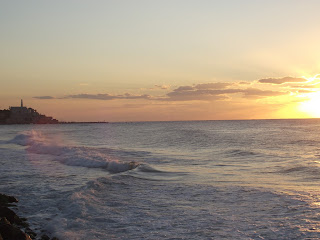We took part in an interesting guided walking tour through the "White City", which belongs to the UNESCO world culture heritage. Tel Aviv is the city with the largest number of Bauhaus buildings worldwide. The Bauhaus style was developed in Weimar and Dessau between 1919 and 1933. It combined fine arts, architecture and design by a fusion of handcraft and arts such that the style should be present also in every day life. The Nazis considered it as "socialist, degenerate arts". Under pressure, the first Bauhaus school in Weimar closed and re-opened in Dessau. However, the Jewish artists and architects were in danger and fled to Palestine. At that time, Tel Aviv was growing very fast and a new neighbourhood was built in the Bauhaus style that is characterised by its functionality with interesting forms and some decorations, mostly in white. The tour started on the elegant Rothschild Boulevard where one can see historical buildings next to modern towers.
After the tour with walking and standing, we were quite cold and drank for the first time a coffee in an Aroma café. Aroma is the largest and most popular chain of cafés in Israel, you can find them virtually everywhere. On the first floor of Aroma, we enjoyed both the warm coffee and the view over the Rothschild Boulevard and the people walking or jogging along.
Next, we visited the beautiful Neve Zedek, a district with a creative flair, full of cafés, restaurants, small design shops, a pretty square with dance and theatre studios around. We enjoyed walking around and ended up at the sea where we also observed the sunset before dinner in a stylish & cosy vegan restaurant in Neve Zedek. The night was still young and we joined the party at the cocktail bar of the brother of our friend and colleague Avital. He celebrated the first anniversary of his bar in Florentin, a hip part of town where many students live.
After a long and beautiful day, we took a sherut back to Rehovot although trains were operating again on Saturday evening, but the walking distance to and from the sherut was shorter and the price is almost the same as by train.












Keine Kommentare:
Kommentar veröffentlichen